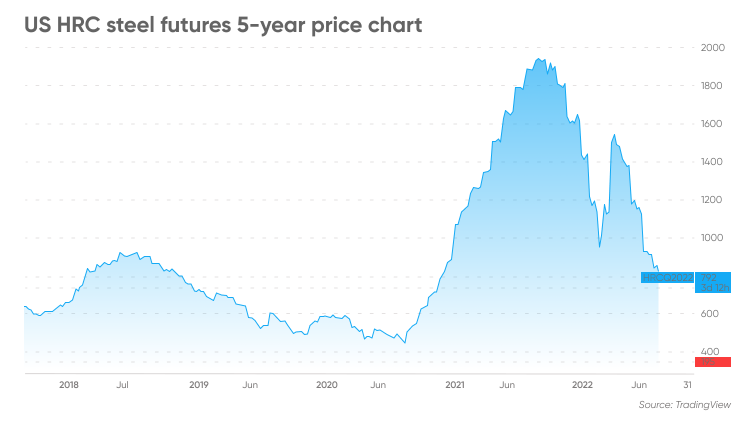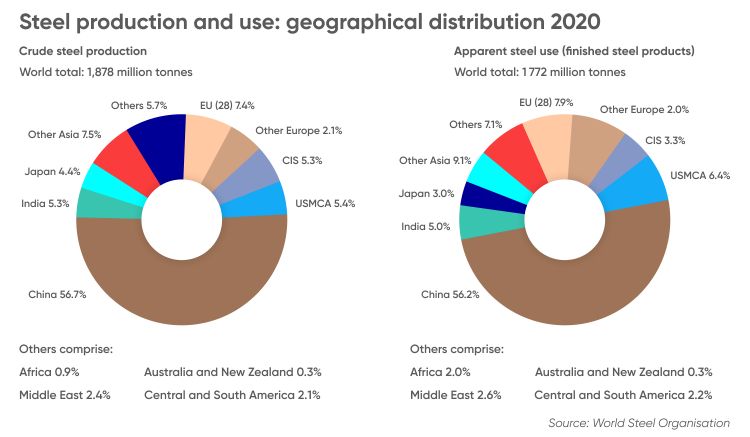Scan to Download iOS&Android APP
By Yoke Wong
Edited by Vanessa Kintu
07:57, 31 August 2022
US steel futures prices fell to a near two-year low in late August as lower consumption and rising energy costs amid a gloomy short-term demand outlook pressured the global market.
The US Midwest Domestic Hot-Rolled Coil (HRC) Steel (CRU) September index futures traded on the Chicago Mercantile Exchange (CME) fell to $884 per short ton on 29 August – the lowest since 22 November 2020 and down 10.4% on a month ago.
Steel production is energy-intensive. Multi-year high oil and natural gas prices have pushed operation costs up for steel mills. Slower economic growth due to rising inflation, interest rate rises and recession fears have dampened steel demand, causing prices to fall.
Steel prices are driven by supply and demand. Consumption for steel is closely related to the property and vehicle markets. High consumer demand for real estate and vehicles can support demand for the metal.
Are you interested to learn more about steel commodity futures? Read this steel futures analysis for the latest market development and outlook, and analysts’ views.
Steel futures are derivatives with different grades of steel as the underlying assets. Contracts are traded on exchanges, like the CME and the Shanghai Futures Exchange (SHFE).
Steel futures are contracts for steel set for forward delivery at a set price on a set date. Steel is widely used for construction, car manufacturing, appliances and wind turbines. It is one of the most traded metals by volume globally.
According to industry body the World Steel Association (WSA), there are over 3,500 different grades of steel, with each product catering to different applications. The most widely traded grades on exchanges are hot-rolled coil (HRC) and reinforcing bar (rebar).
HRC steel is roll-pressed at very high temperatures (over 900˚C), which results in products that are easier to work with. This grade of steel is the key steel contract traded at CME, with a minimum unit of 20 short tonnes.
CME HRC steel futures are financially settled against industry-approved indices published by price reporting agency CRU.
Rebar is a steel bar used in construction to reinforce concrete and masonry structures. This grade of steel is the underlying assets for the SHFE steel rebar futures, with a minimum trading volume of 10 tonnes per contract. In contrast to CME, SHFE rebar futures are settled by physical delivery.
Market participants use steel futures to trade and hedge risk against unfavourable price movements. As evidenced by the steel futures chart (above), prices have been volatile since the start of the year. According to CME data, the forward contract prices started the year at $1,438 a short tonne and briefly fell below $1,000 for two days on 23-24 February before rebounding for the rest of the first quarter.
As evidenced by the steel futures chart (above), prices have been volatile since the start of the year. According to CME data, the forward contract prices started the year at $1,438 a short tonne and briefly fell below $1,000 for two days on 23-24 February before rebounding for the rest of the first quarter.
Following Russia’s invasion of Ukraine on 24 February, the market was driven by supply concerns, as Russia and Ukraine are both major steel producers. The US steel market prices for delivery in the forward month jumped, hitting a high of $1,537 on 23 March.
However, sentiment turned as China imposed strict lockdowns in several Chinese cities in early April, causing steel futures prices to fall in subsequent weeks.
Pressured by slower global economic growth and China’s real estate downturn, the US steel futures price continued to fall in the third quarter, dropping below $800 in mid-August.
In 2021, the US HRC price was rising for most of the year, and hit a record high of $1,941 on 22-29 August 2021 before falling in the fourth quarter.
Oil – Crude
Gold
Oil – Brent
Silver
China is the world’s largest steel producer and consumer, accounting for more than half of global output and finished steel demand. According to the WSA, in 2020 China produced 1.053 billion tonnes of crude steel (56.7% of global output) and consumed 995 million tonnes of finished steel products (56.2% of global apparent steel use).
China’s domestic steel demand has been largely supported by infrastructure and real estate projects over the past decade. However, the Chinese property market started to weaken as the country’s second largest and most indebted developer, Evergrande (3333), failed to meet debt liabilities at the beginning of this year.
Beijing’s zero-Covid policy further slowed economic growth, impeding the country’s real estate sector recovery.
According to rating agency Fitch Ratings, China has yet to see sustainable recovery in its land market, as of August, with nationwide land sales continuing to slump by 42.2% year-on-year (YOY) to CNY2.4trn ($247.7bn) in July 2022.
In response to faltering economic growth, the government announced further stimulus measures on 24 August. Beijing will be investing more than CNY1trn to improve infrastructure, ease power shortage, implement drought management and food security.
Warren Patterson, head of commodities strategy at Dutch banking and financial service provider ING, said on 29 June:
However, Patterson warned that China “has a considerable amount of steel inventories to eat into” and “the industry will need to draw this stock down to normal levels before [China’s steel market] can see a meaningful recovery in margin.”
Steel demand in Europe is expected to fall for the rest of 2022 on uncertainty fuelled by the ongoing energy crisis, inflation, supply chain disruptions and Russia’s war in Ukraine, said the European Steel Association (EUROFER) on 24 August.
Due to the ongoing war in Ukraine and high energy prices, production costs and worsening supply chain disruption, the EUROFER has halved its previous steel-using sectors’ output growth for 2022 to 1.1%, down from the previous projection of 2%.
Price reporting agency IHS Markit believed that steel prices in Europe could only be lifted if energy shortages restrict production.
Will steel prices fall fast and reach a bottom by the end of 2022, or will the decline stretch into 2023.
According to technical analysis by MarketClub, the HRC August 2022 contract is showing a strong downtrend: “HRC.Q22 is showing short-term strength. However, look for the longer-term bearish trend to resume”.
Note that analysts’ predictions of the future of steel prices can be wrong. Forecasts shouldn’t be used as a substitute for your own research. Always conduct your own due diligence before investing. And never invest or trade money you cannot afford to lose.
Many analysts believe steel prices could soften further because of weak demand. However, analysts’ forecasts can be wrong. With uncertainty caused by the war in Ukraine, market volatility and other factors, it is unclear whether steel prices will go up or down in 2022.
Supply and demand affect the steel price. The cost of raw materials are key drivers in moving steel prices. As steelmaking is an energy intensive process, the price of oil and gas will also affect prices.
Steel demand is closely related to the property and vehicle markets. When consumer demand for real estates and vehicles is high, demand and prices are supported.
Whether steel is a good investment for you or not will depend on your portfolio composition, risk profile and investing goals. Only you can decide if steel is a good investment for you or not. Always conduct your own due diligence before investing. And never invest or trade money you cannot afford to lose.
There are currently no responses for this story.
Be the first to respond.
Most traded
Most traded
Most traded
Most traded
Most traded
Most traded
Join the 455.000+ traders worldwide that chose to trade with Capital.com
Also you can contact us: call +44 20 8089 7893 • [email protected]
CFDs are complex instruments and come with a high risk of losing money rapidly due to leverage. 81.40% of retail investor accounts lose money when trading CFDs with this provider. You should consider whether you understand how CFDs work and whether you can afford to take the high risk of losing your money. Risk Disclosure Statement
The value of shares and ETFs bought through a share dealing account can fall as well as rise, which could mean getting back less than you originally put in. Past performance is no guarantee of future results.
Risk warning: сonducting operations with non-deliverable over-the-counter instruments are a risky activity and can bring not only profit but also losses. The size of the potential loss is limited to the funds held by us for and on your behalf, in relation to your trading account. Past profits do not guarantee future profits. Use the training services of our company to understand the risks before you start operations.
Capital Com SV Investments Limited is regulated by Cyprus Securities and Exchange Commission (CySEC) under license number 319/17. Capital Com SV Investments Limited, company Registration Number: 354252, registered address: 28 Octovriou 237, Lophitis Business Center II, 6th floor, 3035, Limassol, Cyprus.